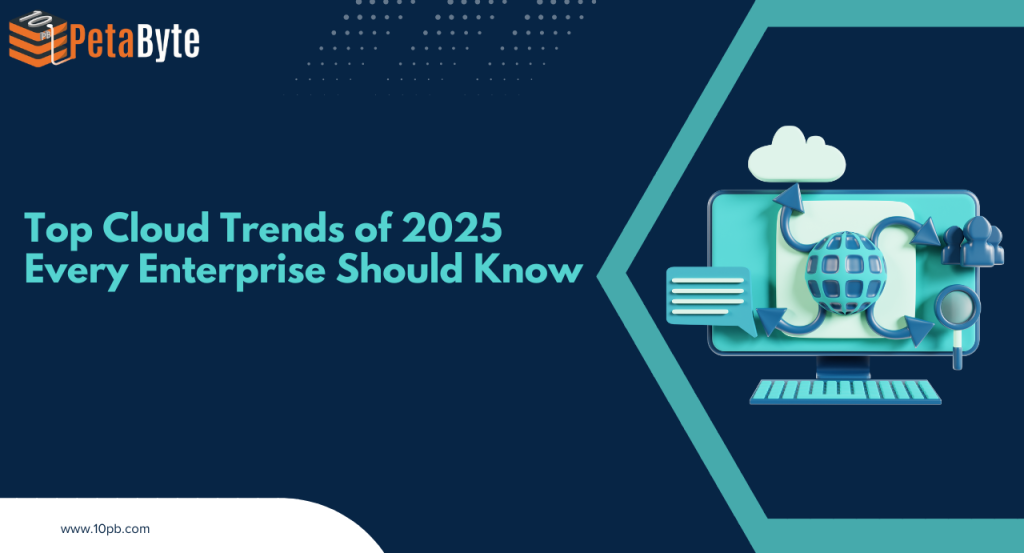The cloud is no longer a storage choice — it’s the backbone of digital transformation. As we enter 2025, businesses are putting more into cloud technology not only for flexibility, but also for competitive edge. From AI-enabled infrastructure to eco-friendly cloud computing, cloud trends in 2025 are revolutionizing the way companies do business, innovate, and expand.
In this blog article, we will explore the most sought-after cloud trends of 2025 which every forward-thinking enterprise needs to be aware of. Be you a CTO, an IT Head, or a Cloud Architect, these trends offer actionable data on enterprise cloud adoption strategies for the forthcoming year.
1. AI-Native Cloud Trends of 2025
2025 is the year AI and cloud go hand in hand. Businesses now use AI-native cloud platforms to enhance automation, observability, and cost savings.
Why it matters: AI algorithms built into cloud platforms can tune workload distribution, anticipate failures, and minimize downtime.
Real-world application: In industries such as e-commerce and finance, AI-driven cloud platforms are already deployed in use cases such as fraud detection, recommendation engines, and smart workload management.
2. Hybrid Cloud Becomes the Default Enterprise Strategy
Those days of deciding between public or private clouds are behind us. Now it’s all about flexibility. A hybrid cloud approach enables enterprises to balance cost, compliance, and performance — and it’s quickly becoming the norm.
Benefits:
- Store sensitive data on-premises while employing public cloud for scalability.
- Improved regulatory compliance in the areas where there are rigid data sovereignty regulations.
- By IDC, more than 80% of big businesses will have hybrid cloud models by the end of 2025.
3. Sustainable Cloud Is Now a Business Priority
Sustainability is no longer a buzzword. As energy costs go up and ESG rules get stricter, green cloud computing has become a high priority.
How businesses are reacting:
- Selecting carbon-neutral cloud providers with green data centers.
- Leaving energy-efficient hardware and serverless frameworks behind.
- Monitoring cloud usage and avoiding resource wastage.
4. Edge Computing Fuels Real-Time Innovation
With 5G deployments gaining momentum around the globe, edge computing becomes an essential requirement for real-time applications like IoT, autonomous vehicles, and remote automation.
Why it’s happening:
- Saves latency by processing data nearer to the origin.
- Perfect for sectors such as manufacturing, healthcare, and logistics.
Use Case: A hospital utilizing edge cloud to monitor life-critical patients in real-time without depending on a far-off data center.
5. Cloud Security Gets Smarter & More Proactive
Security has never been an issue with cloud adoption, but in 2025, cloud security is shifting from reactive to proactive.
Trends to watch:
- AI-based threat detection systems.
- Zero-trust architecture being adopted across cloud networks.
- Biometric and multi-factor authentication becoming ubiquitous.
- With data breaches costing companies an average of $4.45 million, secure cloud architecture is no longer a nicety — it’s a necessity.
Among the most pressing cloud trends in 2025 is the requirement for smart, AI-based cloud security, particularly for enterprise cloud adoption at scale.
6. Cloud-Native Applications Take Over Legacy Systems
Legacy infrastructure is quickly becoming a bottleneck. More enterprises are now migrating to cloud-native applications built on containers, microservices, and serverless frameworks.
Why businesses are investing:
- Shorter development cycles and upgrading.
- Greater scalability and portability between cloud providers.
- Lower maintenance burdens.
7. Data Sovereignty and Localization Drive Cloud Decisions
Government agencies around the world are implementing stricter data sovereignty regulations, compelling companies to house and process data inside their own geographical region.
How it’s changing the game:
- Companies should select cloud providers with local data centers.
- Compliance-ready cloud infrastructure demand is at record levels.
- 10PB, for instance, offers India-based Tier IV cloud infrastructure — perfect for companies that want complete compliance with Indian data protection laws.
8. Multi-Cloud Strategies Minimize Vendor Lock-In
In 2025, multi-cloud is now a primary strategy to minimize dependence on a sole provider.
Advantages:
- Increased pricing flexibility.
- Redundancy and disaster recovery.
- Improved exploitation of various platforms’ capabilities (e.g., AI capability of Google Cloud, global presence of AWS, local regulation of 10PB).
- Smart enterprise cloud adoption in 2025 centers on establishing a strong, multi-cloud environment.
Final Thoughts: Embrace the Change, Lead the Future
The 2025 cloud trends aren’t just ideas for the future — they’re already changing how business is done. Whether modernizing legacy, scaling workloads worldwide, or maintaining compliance, conforming to these trends can be a winning strategy for your organization.
If you’re looking for a cloud partner that understands these trends and delivers enterprise-grade solutions — 10PB is your answer. With a Tier IV data center backbone, object storage, and secure multi-cloud capabilities, 10PB is powered by Netforchoice which helps enterprises confidently adopt the cloud for today and tomorrow.

